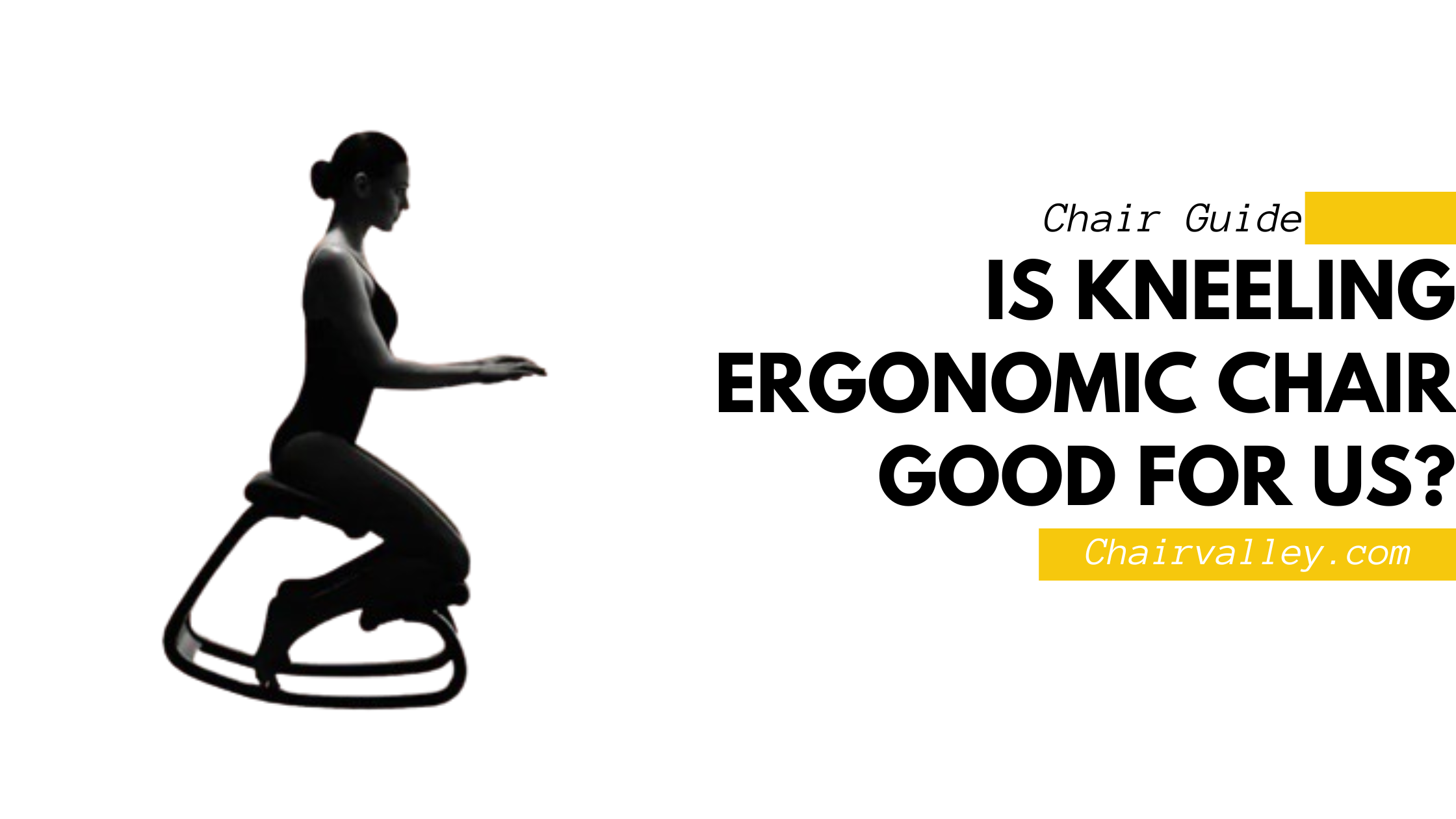Many of us when we see a kneeling chair we think how it will be used and what is the history back of this chair design. So here I write this article about this chair design where all your questions will be cleared after reading this one.
Let’s start from what is kneeling chair:
What is a Kneeling chair?
A kneeling chair is an ergonomic chair designed to better support the body and reduce stress on the back. Unlike traditional chairs, kneeling chairs usually feature forward-facing seats and knee supports that encourage hip opening and greater distribution of body weight.
This design is designed to maintain the natural curve of the spine, activate muscles, and promote a strong and active sitting position.
History of kneeling chair:
The kneeling ergonomic chair, a unique and innovative seating solution, has an intriguing history rooted in the pursuit of better posture and ergonomic health. Let’s take a journey through its origins and development.
The Origins: The concept of the kneeling chair can be traced back to the 1970s. At this time, there was growing awareness about the importance of ergonomics and the impact of prolonged sitting on health.
Traditional chairs were increasingly being criticized for contributing to poor posture and back pain. This spurred designers and ergonomists to explore alternative seating solutions.
The Innovator: Peter Opsvik: The most famous name in the history of the kneeling chair is Norwegian industrial designer Peter Opsvik. In 1979, Opsvik, together with his colleagues, created the first modern kneeling chair, called the Balans chair.
Opsvik’s design is revolutionary with its front seat and knee support. This design is designed to promote the opening of the hip angle, develop a beautiful face and expand body weight.
The Balans Chair:The original Balans chair was a departure from conventional seating. Its distinctive design included:
Forward-Tilted Seat: The seat tilts forward, encouraging the sitter to lean forward slightly, encouraging upright posture and reducing the tendency to slouch.
Knee Rests: They support the lower legs and help distribute weight between the hips and knees. This design is designed to reduce the height of the back and improve the spine.
How to Use a Kneeling Chair?
Using a kneeling chair involves several key steps to ensure proper posture and comfort:
1.Adjust the Chair: Remember to adjust the height and angle of the seat to fit your body. The seat should lean forward at an angle to avoid discomfort, and the knee support should support your legs.
2.Sit Correctly: Sit in a chair with your knees on the knee pads. Your weight should be distributed between your hips and thighs. Keep your hips open at an angle to support spinal alignment.
3.Take Breaks: It’s important to take regular breaks and change positions regularly to avoid fatigue and discomfort. Stand up, stretch, and move around to stay calm and relaxed.
Benefits of Kneeling Chairs:
1.Improved Posture: The front seat provides more support to the body, helps control the curvature of the spine and reduces the risk of slouching.
2.Reduced Back Pain: Kneeling chairs can reduce back pain and discomfort by distributing weight more evenly and aligning the spine.
3.Enhanced Core Strength: Sitting in a kneeling chair works your muscles more than sitting in a regular chair, which can increase core strength and stability over time.
4.Increased Focus and Productivity: Some users report that upright posture and sitting accountable helps them be more focused and productive during their workday.
5.Ergonomic Benefits:Designed to reduce back pressure, improve spinal alignment and increase sitting strength, helping to prevent musculoskeletal problems associated with prolonged sitting.
Drawbacks of Kneeling Chairs:
1.Knee and Shin Discomfort: It will cause discomfort due to the pressure and shine on your knees in long-term use. This can be resolved with padded knee supports and regular rest.
2.Adaptation Period: Transitioning to a kneeling chair can be challenging. An initial adjustment period may involve discomfort as your body adapts to the new sitting posture.
3.Limited Mobility: Switching to a kneeling chair isn’t as easy as a regular office chair, which can be a disadvantage for people who need to shift or reach for things frequently.
Reviews of People Who Use Kneeling Chairs:
Emma, the Freelance Writer:
Emma sat at her desk for long periods of time. After switching to a kneeling chair to manage her lower back pain, she noticed significant improvement in her body and reduced pain within a few weeks.
Now Emma swears by her kneeling chair and credits it with having a positive impact on her work and overall health.
Mark, the Software Developer:
Mark thought of the idea of a kneeling chair and decided to try it. Initially, he felt more honesty and collaboration in his work. However, after a few months, he began to experience uncomfortable knee pain.
Mark can now switch between a kneeling chair and a regular office chair, allowing him to enjoy the benefits without chronic knee discomfort.
Sarah, the Office Manager:
Sarah introduced the kneeling chair to her team to help them improve posture. The response was mixed. Some workers, including Sarah, have adapted well and say they are comfortable, while others prefer to use regular chairs. Sarah concluded that the kneeling chair should be an option, not a requirement.
You must read more experiences of people to satisfy yourself about kneeling chair use.
Types of Kneeling Chairs:
Basic Kneeling Chairs: These are simple designs with forward-leaning seats and knee pads. They are usually made of wood or metal and may have less padding.
Adjustable Kneeling Chairs: This model features an adjustable seat and knee height to accommodate different body types and preferences. Adjustability increases comfort and provides ergonomic support.
Padded Kneeling Chairs: These chairs have extra padding in the seat and knee support for extra comfort, especially when used for long periods of time.
Wheeled Kneeling Chairs: Some kneeling chairs are equipped with wheels or casters, allowing for greater mobility and ease of movement within a workspace.
Swivel Kneeling Chairs: These chairs feature a swivel base, offering the ability to rotate and adjust position without standing up, adding to their convenience and functionality
Ergonomic Kneeling Chair:
An ergonomic kneeling chair is designed with specific features to enhance comfort and support:
1.Adjustable Seat and Knee Pads: To accommodate different body types and preferences, the seat and knee height of an ergonomic knee chair should be adjustable.
2.Padded Knee Rests: The high-quality padding in the knee brace helps reduce discomfort and pressure on your calves and knees.
3.Durable Construction: The sturdy frame and good materials ensure the chair’s longevity and reliable support.
4.Mobility Options:Some ergonomic kneeling chairs come with wheels or a swivel base to allow for greater mobility and flexibility in the workplace.
Conclusion:
Ergonomic knee pads have a special way of supporting the body and reducing back pain. While they provide obvious benefits, such as increasing core strength and spinal control, they also have their drawbacks.
Emma, Mark, and Sarah’s experiences show that personal preferences and preferences play a significant role in determining the effectiveness of a kneeling chair, including your own needs and how you like the design.
If you’re considering making a change, it’s a good idea to try it for a while, gradually increase your use, and let your body get used to it. Providing regular rests and a kneeling chair with multiple seating positions can help you find your balance with an ergonomic chair.






